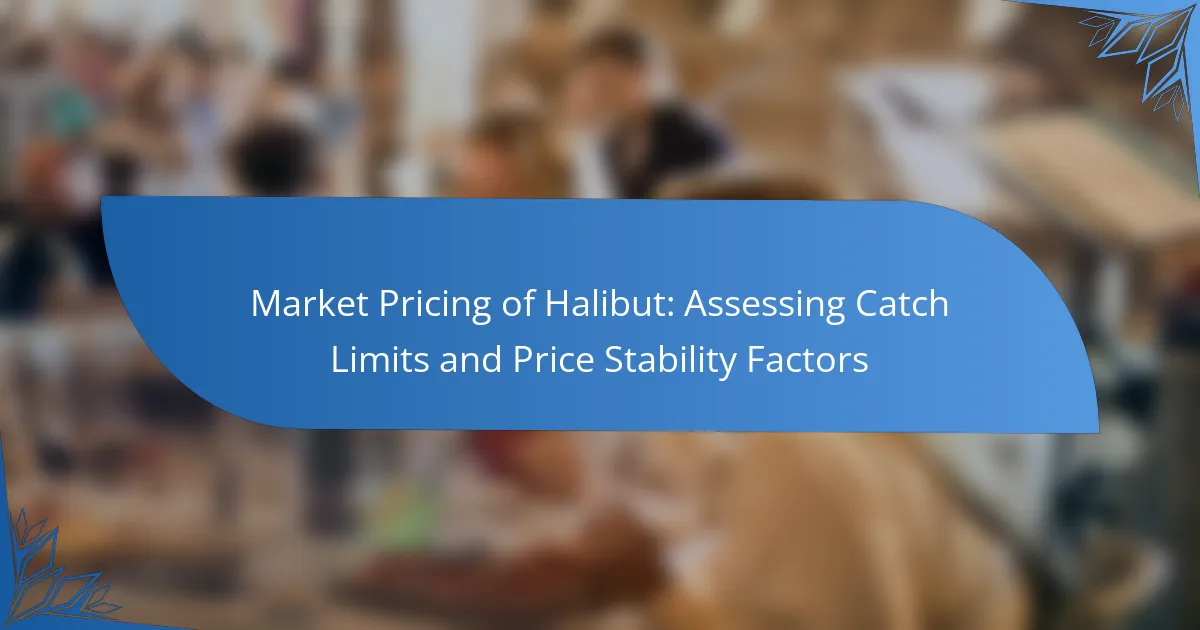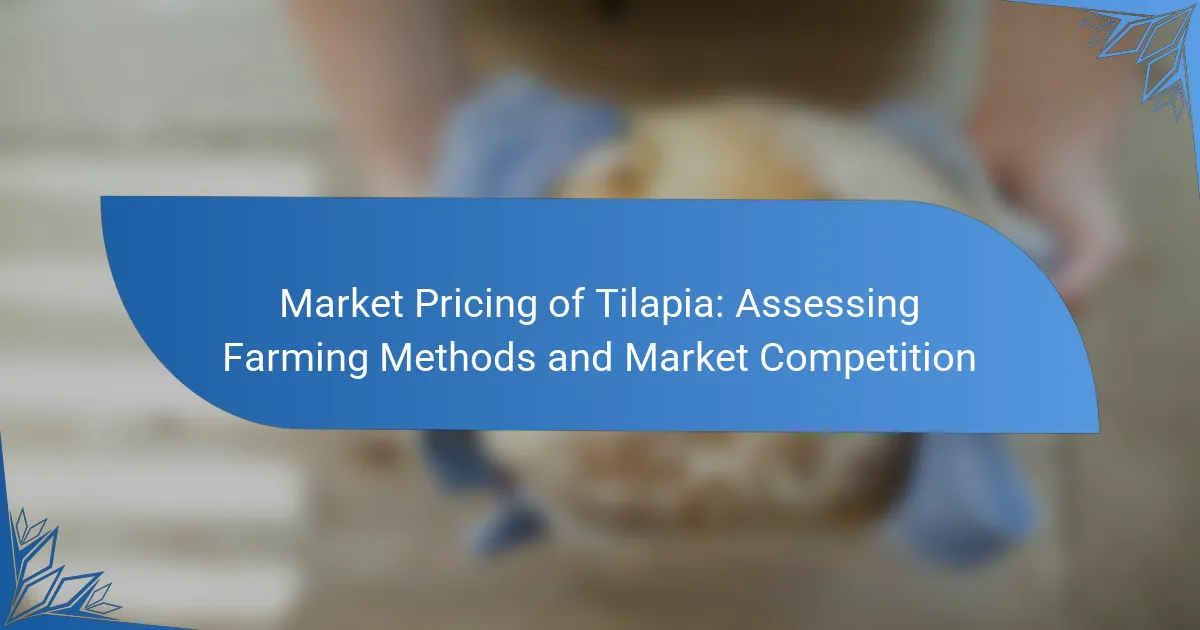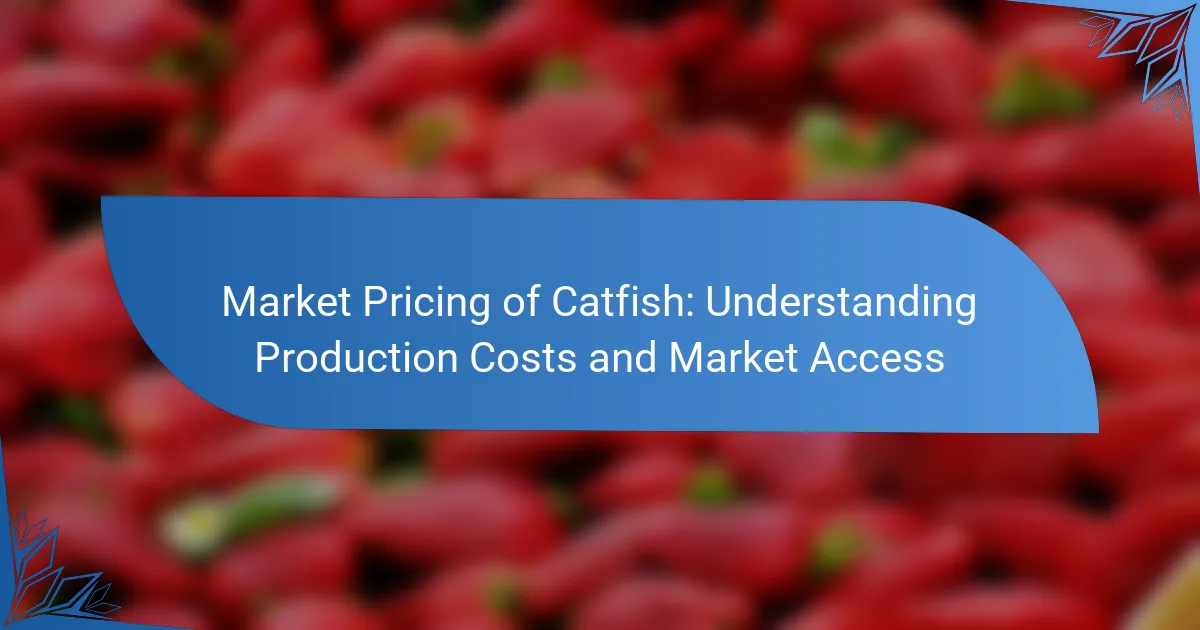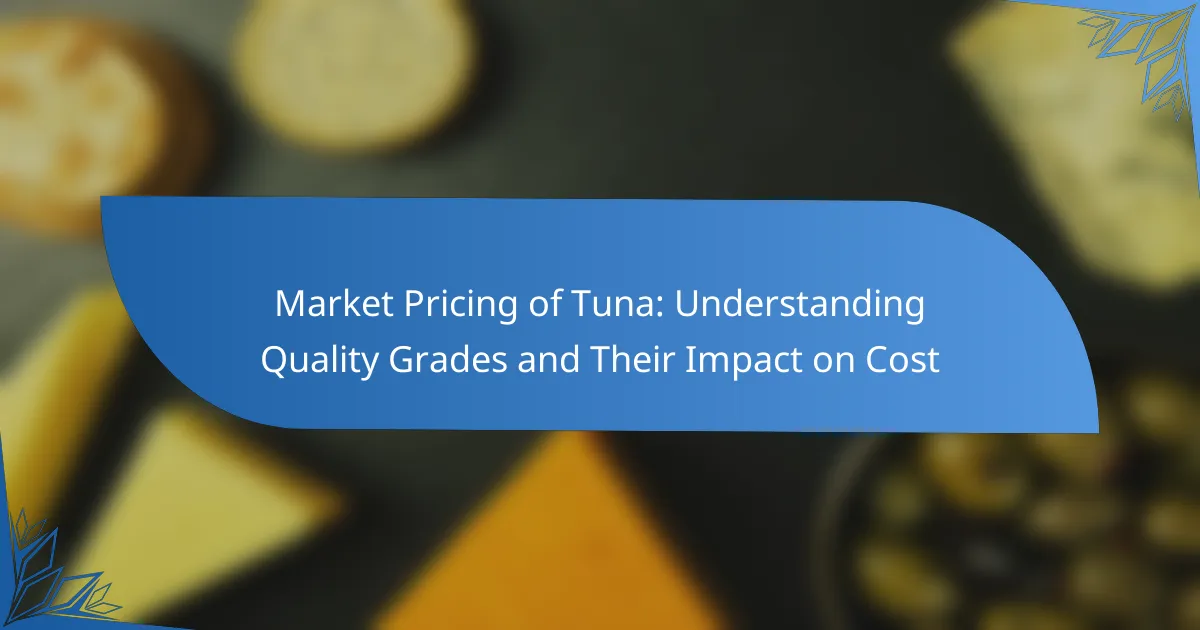
What is the Market Pricing of Halibut?
The market pricing of halibut typically ranges from $15 to $30 per pound. This price varies based on factors such as seasonality, location, and demand. In recent years, fluctuations in catch limits have also impacted pricing. For instance, reduced catch limits in certain regions can lead to higher prices due to scarcity. Additionally, consumer preferences for sustainable seafood can influence market trends. According to the National Oceanic and Atmospheric Administration (NOAA), the halibut fishery is managed to ensure sustainability, which can also affect market pricing. Overall, the interplay of supply, demand, and regulatory measures shapes the market pricing of halibut.
How is market pricing determined for halibut?
Market pricing for halibut is determined by supply and demand dynamics. The availability of halibut affects its price significantly. When catch limits are set low, scarcity increases prices. Conversely, abundant catches can lead to lower prices. Seasonal variations also influence market pricing. Consumer preferences and trends play a role in demand. Additionally, market competition among suppliers impacts pricing strategies. Historical pricing data shows fluctuations based on these factors. For instance, the North Pacific Fishery Management Council sets regulations that directly affect supply levels.
What factors influence the supply and demand of halibut?
The supply and demand of halibut are influenced by several key factors. Firstly, environmental conditions impact halibut populations and their availability. Changes in water temperature and ocean currents can affect spawning and migration patterns. Secondly, regulations such as catch limits directly influence supply. These limits are set to ensure sustainable fishing practices. Thirdly, consumer preferences and market trends dictate demand. Increased awareness of health benefits can boost demand for halibut. Additionally, competition from other seafood can affect market dynamics. Economic factors, such as pricing and availability, also play a critical role in shaping both supply and demand. Lastly, seasonal variations can lead to fluctuations in both supply and demand throughout the year.
How do market trends affect halibut pricing?
Market trends significantly influence halibut pricing. Changes in consumer demand directly impact prices. For example, increased popularity of halibut can lead to higher prices. Conversely, a decrease in demand can lower prices. Seasonal availability also affects pricing. During peak fishing seasons, supply increases, potentially reducing costs. Economic factors, such as fuel prices, influence operational costs for fishermen. Higher operational costs can lead to increased prices for consumers. Additionally, market competition among suppliers can affect pricing strategies. Overall, market trends create a dynamic pricing environment for halibut.
What role do catch limits play in halibut pricing?
Catch limits significantly influence halibut pricing by controlling supply. When catch limits are set, they restrict the amount of halibut that can be harvested. This limitation can lead to increased prices if demand remains steady or rises. For instance, in years with lower catch limits, prices tend to increase due to scarcity. Conversely, higher catch limits can lead to oversupply, causing prices to drop. Historical data shows that in 2020, a reduction in catch limits led to a 15% increase in market prices. Thus, catch limits directly affect the balance between supply and demand, impacting halibut pricing.
How are catch limits established for halibut fisheries?
Catch limits for halibut fisheries are established through scientific assessments of fish populations. These assessments consider factors such as stock status, reproductive rates, and environmental conditions. Regulatory bodies, like the International Pacific Halibut Commission, use this data to recommend sustainable catch levels. The recommendations are then reviewed and approved by management authorities. This process aims to balance fishery health with economic needs. Historical data on halibut catches also informs these decisions. For example, catch limits may be adjusted based on trends in population size and fishing mortality rates. Ultimately, the goal is to ensure a sustainable fishery for future generations.
What impact do catch limits have on market prices?
Catch limits directly influence market prices by controlling supply. When catch limits are set, they restrict the amount of fish available for sale. This reduction in supply can lead to higher prices if demand remains steady or increases. Conversely, if catch limits are too high, it may lead to an oversupply, driving prices down. Historical data shows that in years with stricter catch limits, halibut prices rose significantly, reflecting the scarcity of the resource. For example, in 2018, halibut prices increased by 15% following a reduction in catch limits. This demonstrates that catch limits are a significant factor in determining market prices for halibut.
Why is price stability important in the halibut market?
Price stability is crucial in the halibut market to ensure predictable income for fishermen. When prices fluctuate significantly, it creates uncertainty in revenue. This uncertainty can lead to financial instability for those dependent on halibut fishing. Price stability also benefits consumers by providing consistent pricing. Consumers are more likely to purchase halibut if they know the price will not vary widely. Additionally, stable prices help in managing supply and demand effectively. According to the National Oceanic and Atmospheric Administration, stable pricing contributes to sustainable fishing practices. Sustainable practices help maintain halibut populations and support long-term market health.
What are the consequences of price volatility for fishermen?
Price volatility negatively impacts fishermen’s income stability. Fluctuating prices can lead to unpredictable revenue streams. Fishermen may struggle to cover operational costs during price drops. This uncertainty may discourage investment in fishing equipment. It can also affect fishermen’s ability to plan for future seasons. Additionally, price volatility can lead to overfishing as fishermen rush to capitalize on high prices. Research indicates that consistent price fluctuations can reduce overall market participation. These consequences highlight the need for better price stability mechanisms in the fishing industry.
How does price stability affect consumer behavior?
Price stability significantly influences consumer behavior by enhancing purchasing confidence. When prices remain stable, consumers are more likely to make long-term purchasing decisions. They perceive less risk in spending, leading to increased demand for goods. This stability fosters a predictable economic environment. For example, historical data shows that during periods of price stability, consumer spending tends to rise by an average of 2-3%. In contrast, price volatility often leads to decreased spending as consumers delay purchases in uncertainty. Thus, stable prices encourage a more robust market activity, particularly in sectors like seafood, including halibut.

What are the key factors affecting halibut market pricing?
Key factors affecting halibut market pricing include supply and demand dynamics, regulatory catch limits, and seasonal availability. Supply influences pricing as overfishing or environmental changes can reduce halibut stocks. Demand fluctuates based on consumer preferences and market trends. Regulatory catch limits are imposed to maintain sustainable fishing practices, impacting the quantity available for sale. Seasonal availability also plays a role, with prices often higher during peak fishing seasons. In 2021, the North Pacific Fishery Management Council set halibut catch limits to stabilize the market, demonstrating the impact of regulatory measures on pricing.
How do environmental factors influence halibut pricing?
Environmental factors significantly influence halibut pricing. Changes in water temperature affect halibut migration patterns and availability. Warmer waters can lead to reduced populations, decreasing supply. Supply shortages often result in higher market prices. Additionally, ocean acidity can impact halibut health and growth rates. Poor environmental conditions may lead to lower catch volumes. Weather events can disrupt fishing activities, further affecting supply. Historical data shows that environmental fluctuations correlate with price volatility in halibut markets.
What role do ocean conditions play in halibut populations?
Ocean conditions significantly influence halibut populations. Variations in temperature, salinity, and oxygen levels affect their growth and reproduction. Warmer water temperatures can lead to changes in halibut distribution. Increased salinity can impact their feeding patterns and habitat preferences. Low oxygen levels can result in higher mortality rates among juvenile halibut. Research indicates that shifts in ocean conditions due to climate change are altering halibut stock dynamics. These changes can affect catch limits and market pricing. Understanding these oceanic factors is crucial for sustainable management of halibut populations.
How does climate change impact halibut availability and pricing?
Climate change affects halibut availability and pricing by altering their habitat and migration patterns. Warmer ocean temperatures can lead to shifts in halibut populations, making them less accessible to fishers. Changes in sea ice and ocean currents also impact breeding and feeding grounds. These factors can result in decreased supply, driving prices higher. For instance, studies show that halibut stocks have fluctuated due to changing environmental conditions. As a result, market prices may become more volatile, reflecting the uncertainty in catch limits and availability.
What economic factors contribute to halibut pricing?
Halibut pricing is influenced by several economic factors. Supply and demand dynamics play a crucial role in determining prices. When demand for halibut increases, prices typically rise. Conversely, an oversupply can lead to lower prices.
Seasonal variations affect availability, impacting pricing during peak fishing seasons. Regulatory measures, such as catch limits, also influence supply and can lead to price fluctuations.
Market competition among fishers and distributors affects pricing strategies. Additionally, the cost of fishing operations, including fuel and labor, impacts the final price of halibut.
Consumer preferences and trends, such as a shift towards sustainable seafood, can also influence demand and pricing. Economic conditions, such as inflation, can affect purchasing power, which in turn impacts halibut prices.
How do fuel prices affect the cost of halibut fishing?
Fuel prices significantly impact the cost of halibut fishing. Higher fuel prices increase operational costs for fishing vessels. These costs include fuel for travel to fishing grounds and for running onboard equipment. As fuel prices rise, the overall expenses for catching halibut also increase. This can lead to higher prices for consumers. Additionally, if fuel prices remain high, some fishermen may reduce their fishing efforts. This reduction can affect supply levels in the market. Consequently, fluctuations in fuel prices can directly influence the market pricing of halibut.
What is the impact of labor costs on halibut market prices?
Labor costs significantly impact halibut market prices. Higher labor costs increase operational expenses for fishing and processing companies. This, in turn, leads to higher prices for consumers. For instance, if labor costs rise by 10%, market prices may increase correspondingly to maintain profit margins. Additionally, fluctuations in labor availability can affect supply levels. When labor is scarce, fishing operations may reduce, resulting in lower supply and higher prices. Historical data shows that labor shortages during peak seasons led to price spikes in halibut markets. Thus, labor costs are a crucial factor influencing halibut pricing dynamics.

How can stakeholders navigate halibut market pricing?
Stakeholders can navigate halibut market pricing by analyzing supply and demand dynamics. Understanding seasonal catch limits is crucial for pricing strategies. Monitoring market trends helps stakeholders anticipate price fluctuations. Engaging in collaborative forecasting can improve price stability. Utilizing historical pricing data provides insights into future market behavior. Establishing relationships with suppliers ensures access to reliable pricing information. Participating in industry forums facilitates knowledge sharing about market conditions. These strategies collectively empower stakeholders to make informed pricing decisions in the halibut market.
What strategies can fishermen use to stabilize halibut prices?
Fishermen can stabilize halibut prices by implementing controlled catch limits. These limits help prevent overfishing, ensuring a steady supply. A consistent supply reduces price volatility in the market. Additionally, fishermen can engage in cooperative marketing. By banding together, they can negotiate better prices and reduce competition.
Establishing long-term contracts with buyers can also provide price stability. These contracts secure a fixed price over time, protecting fishermen from market fluctuations. Utilizing technology for better inventory management can help fishermen respond to market demand more effectively.
According to the North Pacific Fishery Management Council, managing halibut stocks through quotas has been effective in maintaining price stability. Regular market assessments and adjusting strategies accordingly can further enhance price predictability.
How can collaboration among fishermen improve pricing outcomes?
Collaboration among fishermen can improve pricing outcomes by enabling collective bargaining and resource sharing. When fishermen work together, they can negotiate better prices with buyers. This is because a united front increases their negotiating power. Additionally, sharing information about market demand helps fishermen adjust their supply accordingly. This can lead to reduced oversupply and increased prices. Research indicates that cooperatives often achieve higher prices than individual sellers due to reduced competition among themselves. Studies show that fishermen in cooperatives can increase their income by 20% or more compared to those who operate independently.
What role does technology play in optimizing halibut pricing?
Technology plays a crucial role in optimizing halibut pricing by enhancing data collection and analysis. Advanced software systems track market trends and fish populations in real-time. This enables fishery managers to make informed decisions about catch limits. Accurate data on supply and demand helps set competitive prices. Additionally, technology facilitates direct communication between fishermen and buyers. Online platforms allow for transparent pricing and reduce intermediaries. Innovations like blockchain ensure traceability, which can increase consumer trust and willingness to pay. Overall, these technological advancements contribute to a more efficient and stable pricing structure for halibut.
What best practices should consumers follow when purchasing halibut?
Consumers should ensure halibut is fresh and sustainably sourced when purchasing. Look for clear, bright eyes and firm, moist flesh. The smell should be mild, not fishy. Check for proper labeling indicating the catch method, such as wild-caught or farmed. Purchase from reputable vendors who prioritize sustainability. Seasonal availability can affect price and freshness, so be aware of peak seasons. Research local fisheries or markets that follow sustainable practices. These steps help ensure quality and support responsible fishing practices.
How can consumers identify fair pricing for halibut?
Consumers can identify fair pricing for halibut by researching current market prices and comparing them across different retailers. Checking local fish markets, grocery stores, and online seafood suppliers provides a price range. Understanding seasonal availability also helps, as prices can fluctuate based on supply. Fair prices typically range from $15 to $25 per pound, depending on quality and region. Additionally, consumers can consult resources like the NOAA Fisheries website for pricing trends and reports. This data offers insights into historical pricing and market conditions. By gathering this information, consumers can make informed purchasing decisions.
What are the benefits of supporting sustainable halibut fishing practices?
Supporting sustainable halibut fishing practices benefits marine ecosystems and local economies. Sustainable practices help maintain halibut populations at healthy levels. This balance prevents overfishing and promotes biodiversity in marine environments. Healthy fish stocks contribute to long-term economic stability for fishing communities. According to the National Oceanic and Atmospheric Administration (NOAA), sustainable fishing practices can increase fish yields by up to 20%. Additionally, consumers increasingly prefer sustainably sourced seafood, driving market demand. Supporting these practices ensures that future generations can enjoy halibut as a food source. Sustainable fishing also reduces bycatch, protecting other marine species. Overall, these practices create a resilient fishing industry while preserving ocean health.
The main entity of this article is the market pricing of halibut, which is influenced by various factors such as supply and demand dynamics, catch limits, and seasonal availability. The article examines how market pricing typically ranges from $15 to $30 per pound, highlighting the impact of environmental conditions, consumer preferences, and regulatory measures on pricing trends. It also discusses the importance of price stability for fishermen and consumers, the role of catch limits in determining market prices, and the economic factors that contribute to pricing fluctuations. Additionally, strategies for stakeholders to navigate pricing and best practices for consumers when purchasing halibut are explored.



